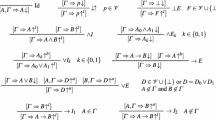Abstract
The aim of this paper is to investigate two related aspects of human reasoning, and use the results to construct an automated theorem prover for the predicate calculus that at least approximately models human reasoning. The result is a non-resolution theorem prover that does not use Skolemization. It involves two central ideas. One is the interest constraints that are of central importance in guiding human reasoning. The other is the notion of suppositional reasoning, wherein one makes a supposition, draws inferences that depend upon that supposition, and then infers a conclusion that does not depend upon it. Suppositional reasoning is involved in the use of conditionals and reductio ad absurdum, and is central to human reasoning with quantifiers. The resulting theorem prover turns out to be surprisingly efficient, beating most resolution theorem provers on some hard problems.
Similar content being viewed by others
References
Andrews, P. B., Pfenning, F., Issar, S., and Klapper, C. P., ‘The TPS theorem proving system’, 8th International Conference on Automated Deduction, J. H. Siekman (ed.), Springer, 1985.
Andrews, P. B., Miller, D. A., Cohen, E. L., and Pfenning, F., ‘Automating higher order logic’, Automated Theorem Proving: After 25 Years, W. W. Bledsoe and D. W. Loveland (eds.), American Mathematical Society, 1983.
Bledsoe W., ‘Non-reduction theorem proving’, Al 9 (1977), 1–35.
Bledsoe, W., ‘Some automatic proofs in analysis’, Automated Theorem Proving: After 25 Years, W. W. Bledsoe and D. W. Loveland (eds.), American Mathematical Society, 1983.
Bledsoe, W. and Tyson, M., ‘The UT interactive theorem prover’, The University of Texas at Austin Math Dept. Memo ATP-17, 1975.
Boyer, R. and Moore, J., A Computational Logic, Academic Press, 1979.
Chang, C. and Lee, R., Symbolic Logic and Mechanical Theorem Proving, Academic Press, 1973.
Cohn, A., ‘On the solution of Schubert's steamroller in many sorted logic’, IJCAI85.
Harman, G., Change in View, MIT Press, 1986.
Lusk, E. and Overbeek, R., ‘The automated reasoning system ITP’, ANL-84-27, Argonne National Laboratory, 1984.
Lusk, E., McCune, W., Overbeek, R., ‘ITP at Argonne National Laboratory’, 8th International Conference on Automated Deduction, J. H. Siekman (ed.), Springer, 1985.
Murray N. V., ‘Completely non-clausal theorem proving’, Artificial Intelligence 18 (1982), 67–85.
Nevins A., ‘A human oriented logic for automatic theorem proving’, J. Assoc. Comput. Mach. 21 (1974), 603–621.
Oppacher, F. and Suen, E., ‘Controlling deduction with proof condensation and heuristics’, 8th International Conference on Automated Deduction, J. H. Siekman (ed.), Springer, 1985.
Oppacher F. and Suen E., ‘HARP: A tableau-based theorem prover’, J. Automated Reasoning 4 (1988), 69–100.
Pelletier, F. J., Completely Non-Clausal, Completely Heuristically Driven, Automated Theorem Proving, Dept. of Computing Science, University of Alberta, Tech. Report TR82-7, 1982.
Pelletier, F. J., ‘THINKER’, 8th International Conference on Automated Deduction, J. H. Siekman (ed.), Springer, 1985.
Pelletier F. J., ‘Seventy-five problems for testing automatic theorem provers’, J. Automated Reasoning 2 (1986) 191–216. See the errata in J. Automated Reasoning 4 (1988) 235–6.
Pollock J., ‘Defeasible reasoning’, Cognitive Science 11 (1987), 481–518.
Pollock, J., How to Build a Person, Bradford/MIT Press, 1989.
Reiter R., ‘A semantically guided deductive system for automatic theorem proving’, IJCAI 3 (1973) 41–46.
Stickel, M. E., ‘The KLAUS Automated Theorem Proving System’, 8th International Conference on Automated Deduction, J. H. Siekman (ed.), Springer, 1985.
Stickel M. E., ‘Schubert's steamroller problem: formulations and solutions’, J. Automated Reasoning 2 (1986) 89–101.
Stickel M. E., ‘A Prolog technology theorem prover: implementation by an extended Prolog compiler’, J. Automated Reasoning 4 (1988) 353–380.
Wilson G. A. and Minker J., ‘Resolution, refinements, and search strategies: A comparative study’, IEEE Transactions on Computers C-25 (1976) 782–801.
Wos, L. and Winker, S., ‘Open questions solved with the assistance of AURA’, Automated Theorem Proving: After 25 Years, W. W. Bledsoe and D. W. Loveland (eds.), American Mathematical Society, 1983.
Author information
Authors and Affiliations
Rights and permissions
About this article
Cite this article
Pollock, J.L. Interest driven suppositional reasoning. J Autom Reasoning 6, 419–461 (1990). https://doi.org/10.1007/BF00244357
Received:
Accepted:
Issue Date:
DOI: https://doi.org/10.1007/BF00244357




